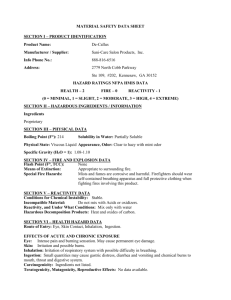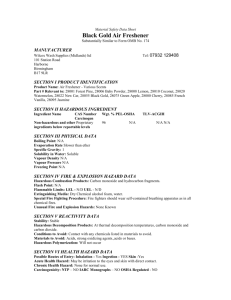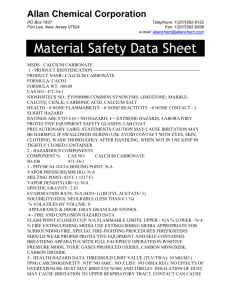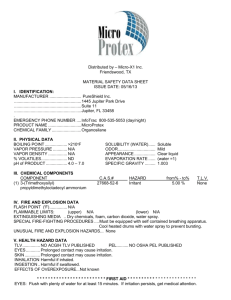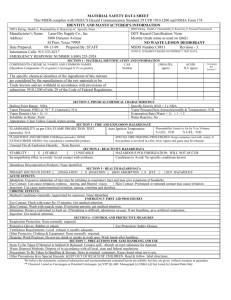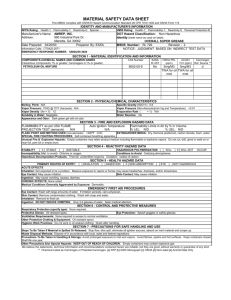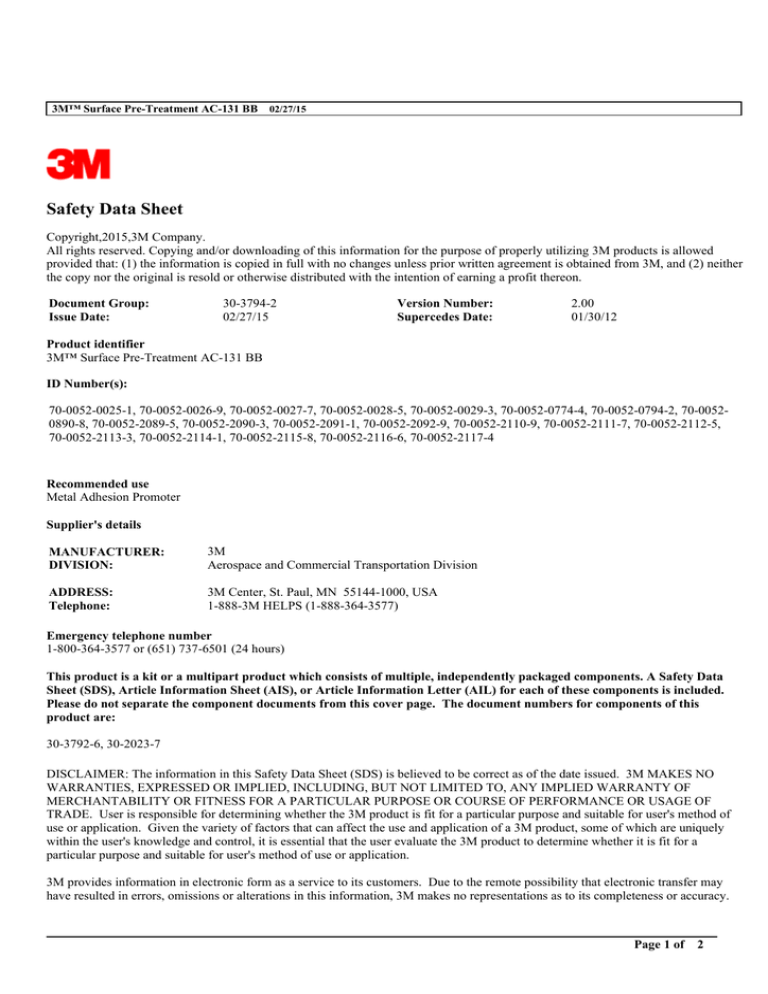
3M™ Surface Pre-Treatment AC-131 BB 02/27/15
Safety Data Sheet
Copyright,2015,3M Company.
All rights reserved. Copying and/or downloading of this information for the purpose of properly utilizing 3M products is allowed
provided that: (1) the information is copied in full with no changes unless prior written agreement is obtained from 3M, and (2) neither
the copy nor the original is resold or otherwise distributed with the intention of earning a profit thereon.
Document Group:
Issue Date:
30-3794-2
02/27/15
Version Number:
Supercedes Date:
2.00
01/30/12
Product identifier
3M™ Surface Pre-Treatment AC-131 BB
ID Number(s):
70-0052-0025-1, 70-0052-0026-9, 70-0052-0027-7, 70-0052-0028-5, 70-0052-0029-3, 70-0052-0774-4, 70-0052-0794-2, 70-00520890-8, 70-0052-2089-5, 70-0052-2090-3, 70-0052-2091-1, 70-0052-2092-9, 70-0052-2110-9, 70-0052-2111-7, 70-0052-2112-5,
70-0052-2113-3, 70-0052-2114-1, 70-0052-2115-8, 70-0052-2116-6, 70-0052-2117-4
Recommended use
Metal Adhesion Promoter
Supplier's details
MANUFACTURER:
DIVISION:
3M
Aerospace and Commercial Transportation Division
ADDRESS:
Telephone:
3M Center, St. Paul, MN 55144-1000, USA
1-888-3M HELPS (1-888-364-3577)
Emergency telephone number
1-800-364-3577 or (651) 737-6501 (24 hours)
This product is a kit or a multipart product which consists of multiple, independently packaged components. A Safety Data
Sheet (SDS), Article Information Sheet (AIS), or Article Information Letter (AIL) for each of these components is included.
Please do not separate the component documents from this cover page. The document numbers for components of this
product are:
30-3792-6, 30-2023-7
DISCLAIMER: The information in this Safety Data Sheet (SDS) is believed to be correct as of the date issued. 3M MAKES NO
WARRANTIES, EXPRESSED OR IMPLIED, INCLUDING, BUT NOT LIMITED TO, ANY IMPLIED WARRANTY OF
MERCHANTABILITY OR FITNESS FOR A PARTICULAR PURPOSE OR COURSE OF PERFORMANCE OR USAGE OF
TRADE. User is responsible for determining whether the 3M product is fit for a particular purpose and suitable for user's method of
use or application. Given the variety of factors that can affect the use and application of a 3M product, some of which are uniquely
within the user's knowledge and control, it is essential that the user evaluate the 3M product to determine whether it is fit for a
particular purpose and suitable for user's method of use or application.
3M provides information in electronic form as a service to its customers. Due to the remote possibility that electronic transfer may
have resulted in errors, omissions or alterations in this information, 3M makes no representations as to its completeness or accuracy.
________________________________________________________________________________________________________
Page 1 of 2
3M™ Surface Pre-Treatment AC-131 BB 02/27/15
In addition, information obtained from a database may not be as current as the information in the SDS available directly from 3M
3M USA SDSs are available at www.3M.com
________________________________________________________________________________________________________
Page 2 of 2
3M™ Surface Pre-Treatment AC-131 BB Part B 02/27/15
Safety Data Sheet
Copyright,2015,3M Company.
All rights reserved. Copying and/or downloading of this information for the purpose of properly utilizing 3M products is
allowed provided that: (1) the information is copied in full with no changes unless prior written agreement is obtained from
3M, and (2) neither the copy nor the original is resold or otherwise distributed with the intention of earning a profit thereon.
Document Group:
Issue Date:
30-3792-6
02/27/15
Version Number:
Supercedes Date:
3.00
03/21/13
SECTION 1: Identification
1.1. Product identifier
3M™ Surface Pre-Treatment AC-131 BB Part B
Product Identification Numbers
LC-B100-1102-8, LC-B100-1102-9, LC-B100-1103-0, LC-B100-1103-1, LC-B100-1103-2, LC-B100-1507-5
1.2. Recommended use and restrictions on use
Recommended use
Part B of Metal Adhesion Promoter, For industrial or professional use only.
1.3. Supplier’s details
MANUFACTURER:
DIVISION:
ADDRESS:
Telephone:
3M
Aerospace and Commercial Transportation Division
3M Center, St. Paul, MN 55144-1000, USA
1-888-3M HELPS (1-888-364-3577)
1.4. Emergency telephone number
1-800-364-3577 or (651) 737-6501 (24 hours)
SECTION 2: Hazard identification
2.1. Hazard classification
Serious Eye Damage/Irritation: Category 1.
Reproductive Toxicity: Category 2.
Specific Target Organ Toxicity (single exposure): Category 1.
2.2. Label elements
Signal word
Danger
Symbols
Corrosion | Health Hazard |
Pictograms
__________________________________________________________________________________________
Page 1 of 10
3M™ Surface Pre-Treatment AC-131 BB Part B 02/27/15
Hazard Statements
Causes serious eye damage.
Suspected of damaging fertility or the unborn child.
Causes damage to organs:
sensory organs |
Precautionary Statements
Prevention:
Obtain special instructions before use.
Do not handle until all safety precautions have been read and understood.
Do not breathe dust/fume/gas/mist/vapors/spray.
Wear protective gloves and eye/face protection.
Do not eat, drink or smoke when using this product.
Wash thoroughly after handling.
Response:
IF IN EYES: Rinse cautiously with water for several minutes. Remove contact lenses, if present and easy to do.
Continue rinsing.
Immediately call a POISON CENTER or doctor/physician.
IF exposed or concerned: Get medical advice/attention.
Specific treatment (see Notes to Physician on this label).
Storage:
Store locked up.
Disposal:
Dispose of contents/container in accordance with applicable local/regional/national/international regulations.
Notes to Physician:
This product contains methanol. Methanol poisoning can cause metabolic acidosis, blindness, and death. Onset of signs or
symptoms may be delayed for 18 to 24 hours. If methanol poisoning is confirmed, intravenous (IV) administration of ethanol
should be considered. Additional pharmacologic and supportive care should be based on the treating physician’s judgement.
2.3. Hazards not otherwise classified
None.
SECTION 3: Composition/information on ingredients
Ingredient
3-(TRIMETHOXYSILYL)PROPYL GLYCIDYL
ETHER
METHYL ALCOHOL
C.A.S. No.
2530-83-8
% by Wt
97 - 100 Trade Secret *
67-56-1
0 - 3 Trade Secret *
*The specific chemical identity and/or exact percentage (concentration) of this composition has been withheld as a trade
secret.
__________________________________________________________________________________________
Page 2 of 10
3M™ Surface Pre-Treatment AC-131 BB Part B 02/27/15
SECTION 4: First aid measures
4.1. Description of first aid measures
Inhalation:
Remove person to fresh air. If you feel unwell, get medical attention.
Skin Contact:
Wash with soap and water. If signs/symptoms develop, get medical attention.
Eye Contact:
Immediately flush with large amounts of water for at least 15 minutes. Remove contact lenses if easy to do. Continue
rinsing. Immediately get medical attention.
If Swallowed:
Rinse mouth. If you feel unwell, get medical attention.
4.2. Most important symptoms and effects, both acute and delayed
See Section 11.1. Information on toxicological effects.
4.3. Indication of any immediate medical attention and special treatment required
This product contains methanol. Methanol poisoning can cause metabolic acidosis, blindness, and death. Onset of signs or
symptoms may be delayed for 18 to 24 hours. If methanol poisoning is confirmed, intravenous (IV) administration of ethanol
should be considered. Additional pharmacologic and supportive care should be based on the treating physician’s judgement.
SECTION 5: Fire-fighting measures
5.1. Suitable extinguishing media
In case of fire: Use a fire fighting agent suitable for ordinary combustible material such as water or foam to extinguish.
5.2. Special hazards arising from the substance or mixture
None inherent in this product.
Hazardous Decomposition or By-Products
Substance
Carbon monoxide
Carbon dioxide
Condition
During Combustion
During Combustion
5.3. Special protective actions for fire-fighters
No special protective actions for fire-fighters are anticipated.
SECTION 6: Accidental release measures
6.1. Personal precautions, protective equipment and emergency procedures
Ventilate the area with fresh air. For large spill, or spills in confined spaces, provide mechanical ventilation to disperse or
exhaust vapors, in accordance with good industrial hygiene practice. Warning! A motor could be an ignition source and could
cause flammable gases or vapors in the spill area to burn or explode. Refer to other sections of this SDS for information
regarding physical and health hazards, respiratory protection, ventilation, and personal protective equipment.
6.2. Environmental precautions
Avoid release to the environment. For larger spills, cover drains and build dikes to prevent entry into sewer systems or
bodies of water.
__________________________________________________________________________________________
Page 3 of 10
3M™ Surface Pre-Treatment AC-131 BB Part B 02/27/15
6.3. Methods and material for containment and cleaning up
Contain spill. Working from around the edges of the spill inward, cover with bentonite, vermiculite, or commercially
available inorganic absorbent material. Mix in sufficient absorbent until it appears dry. Remember, adding an absorbent
material does not remove a physical, health, or environmental hazard. Collect as much of the spilled material as possible.
Place in a closed container approved for transportation by appropriate authorities. Clean up residue with an appropriate
solvent selected by a qualified and authorized person. Ventilate the area with fresh air. Read and follow safety precautions on
the solvent label and SDS. Seal the container. Dispose of collected material as soon as possible.
SECTION 7: Handling and storage
7.1. Precautions for safe handling
Do not handle until all safety precautions have been read and understood. Do not breathe dust/fume/gas/mist/vapors/spray.
Do not get in eyes, on skin, or on clothing. Do not eat, drink or smoke when using this product. Wash thoroughly after
handling. Avoid contact with oxidizing agents (eg. chlorine, chromic acid etc.) Use personal protective equipment (gloves,
respirators, etc.) as required.
7.2. Conditions for safe storage including any incompatibilities
Store away from heat. Store away from oxidizing agents.
SECTION 8: Exposure controls/personal protection
8.1. Control parameters
Occupational exposure limits
If a component is disclosed in section 3 but does not appear in the table below, an occupational exposure limit is not available
for the component.
Ingredient
C.A.S. No. Agency
Limit type
Additional Comments
32530-83-8 CMRG
TWA:5 ppm
(TRIMETHOXYSILYL)PROPY
L GLYCIDYL ETHER
METHYL ALCOHOL
67-56-1
ACGIH
TWA:200 ppm;STEL:250 ppm Skin Notation
METHYL ALCOHOL
67-56-1
OSHA
TWA:260 mg/m3(200 ppm)
ACGIH : American Conference of Governmental Industrial Hygienists
AIHA : American Industrial Hygiene Association
CMRG : Chemical Manufacturer's Recommended Guidelines
OSHA : United States Department of Labor - Occupational Safety and Health Administration
TWA: Time-Weighted-Average
STEL: Short Term Exposure Limit
CEIL: Ceiling
8.2. Exposure controls
8.2.1. Engineering controls
Use general dilution ventilation and/or local exhaust ventilation to control airborne exposures to below relevant Exposure
Limits and/or control dust/fume/gas/mist/vapors/spray. If ventilation is not adequate, use respiratory protection equipment.
8.2.2. Personal protective equipment (PPE)
Eye/face protection
Select and use eye/face protection to prevent contact based on the results of an exposure assessment. The following eye/face
protection(s) are recommended:
Full Face Shield
Indirect Vented Goggles
Skin/hand protection
__________________________________________________________________________________________
Page 4 of 10
3M™ Surface Pre-Treatment AC-131 BB Part B 02/27/15
Select and use gloves and/or protective clothing approved to relevant local standards to prevent skin contact based on the
results of an exposure assessment. Selection should be based on use factors such as exposure levels, concentration of the
substance or mixture, frequency and duration, physical challenges such as temperature extremes, and other use conditions.
Consult with your glove and/or protective clothing manufacturer for selection of appropriate compatible gloves/protective
clothing.
Gloves made from the following material(s) are recommended: Butyl Rubber
Polymer laminate
Respiratory protection
An exposure assessment may be needed to decide if a respirator is required. If a respirator is needed, use respirators as part of
a full respiratory protection program. Based on the results of the exposure assessment, select from the following respirator
type(s) to reduce inhalation exposure:
Half facepiece or full facepiece supplied-air respirator
For questions about suitability for a specific application, consult with your respirator manufacturer.
SECTION 9: Physical and chemical properties
9.1. Information on basic physical and chemical properties
Liquid
General Physical Form:
Clear liquid; slight odor
Odor, Color, Grade:
No Data Available
Odor threshold
Not Applicable
pH
No Data Available
Melting point
No Data Available
Boiling Point
>=200 ºF [Test Method: Closed Cup]
Flash Point
No Data Available
Evaporation rate
Not Applicable
Flammability (solid, gas)
No Data Available
Flammable Limits(LEL)
No Data Available
Flammable Limits(UEL)
1 mmHg [@ 20 ºC]
Vapor Pressure
>=1 [Ref Std: AIR=1]
Vapor Density
1.07 g/ml
Density
1.07 [Ref Std: WATER=1]
Specific Gravity
No Data Available
Solubility in Water
No Data Available
Solubility- non-water
No Data Available
Partition coefficient: n-octanol/ water
Not Applicable
Autoignition temperature
No Data Available
Decomposition temperature
No Data Available
Viscosity
21.4 g/l [Test Method: calculated SCAQMD rule 443.1]
Volatile Organic Compounds
21.4 g/l [Test Method: calculated SCAQMD rule 443.1]
VOC Less H2O & Exempt Solvents
SECTION 10: Stability and reactivity
10.1. Reactivity
This material is considered to be non reactive under normal use conditions.
10.2. Chemical stability
Stable.
10.3. Possibility of hazardous reactions
Hazardous polymerization will not occur.
__________________________________________________________________________________________
Page 5 of 10
3M™ Surface Pre-Treatment AC-131 BB Part B 02/27/15
10.4. Conditions to avoid
Heat
10.5. Incompatible materials
Strong oxidizing agents
10.6. Hazardous decomposition products
Substance
None known.
Condition
Refer to section 5.2 for hazardous decomposition products during combustion.
SECTION 11: Toxicological information
The information below may not be consistent with the material classification in Section 2 if specific ingredient
classifications are mandated by a competent authority. In addition, toxicological data on ingredients may not be
reflected in the material classification and/or the signs and symptoms of exposure, because an ingredient may be
present below the threshold for labeling, an ingredient may not be available for exposure, or the data may not be
relevant to the material as a whole.
11.1. Information on Toxicological effects
Signs and Symptoms of Exposure
Based on test data and/or information on the components, this material may produce the following health effects:
Inhalation:
Respiratory Tract Irritation: Signs/symptoms may include cough, sneezing, nasal discharge, headache, hoarseness, and nose
and throat pain.
May cause additional health effects (see below).
Skin Contact:
May be harmful in contact with skin.
Mild Skin Irritation: Signs/symptoms may include localized redness, swelling, itching, and dryness.
Eye Contact:
Corrosive (Eye Burns): Signs/symptoms may include cloudy appearance of the cornea, chemical burns, severe pain, tearing,
ulcerations, significantly impaired vision or complete loss of vision.
Ingestion:
May be harmful if swallowed.
Gastrointestinal Irritation: Signs/symptoms may include abdominal pain, stomach upset, nausea, vomiting and diarrhea.
May cause additional health effects (see below).
Additional Health Effects:
Single exposure may cause target organ effects:
May cause blindness.
Reproductive/Developmental Toxicity:
Contains a chemical or chemicals which can cause birth defects or other reproductive harm.
__________________________________________________________________________________________
Page 6 of 10
3M™ Surface Pre-Treatment AC-131 BB Part B 02/27/15
Toxicological Data
If a component is disclosed in section 3 but does not appear in a table below, either no data are available for that endpoint or
the data are not sufficient for classification.
Acute Toxicity
Name
Overall product
Route
Dermal
Overall product
InhalationVapor(4 hr)
Ingestion
Overall product
3-(TRIMETHOXYSILYL)PROPYL GLYCIDYL ETHER
3-(TRIMETHOXYSILYL)PROPYL GLYCIDYL ETHER
3-(TRIMETHOXYSILYL)PROPYL GLYCIDYL ETHER
METHYL ALCOHOL
METHYL ALCOHOL
METHYL ALCOHOL
Dermal
InhalationDust/Mist
(4 hours)
Ingestion
Dermal
InhalationVapor
Ingestion
Species
Rabbit
Rat
Rat
Value
No data available; calculated ATE 2,000 - 5,000
mg/kg
No data available; calculated ATE > 50 mg/l
No data available; calculated ATE 2,000 - 5,000
mg/kg
LD50 4,000 mg/kg
LC50 > 5.3 mg/l
LD50 7,010 mg/kg
LD50 estimated to be 1,000 - 2,000 mg/kg
LC50 estimated to be 10 - 20 mg/l
LD50 estimated to be 50 - 300 mg/kg
ATE = acute toxicity estimate
Skin Corrosion/Irritation
Name
Species
Value
3-(TRIMETHOXYSILYL)PROPYL GLYCIDYL ETHER
METHYL ALCOHOL
Rabbit
Rabbit
Mild irritant
Mild irritant
Name
Species
Value
3-(TRIMETHOXYSILYL)PROPYL GLYCIDYL ETHER
METHYL ALCOHOL
Rabbit
Rabbit
Corrosive
Moderate irritant
Species
Guinea
pig
Guinea
pig
Value
Some positive data exist, but the data are not
sufficient for classification
Not sensitizing
Serious Eye Damage/Irritation
Skin Sensitization
Name
3-(TRIMETHOXYSILYL)PROPYL GLYCIDYL ETHER
METHYL ALCOHOL
Respiratory Sensitization
For the component/components, either no data are currently available or the data are not sufficient for classification.
Germ Cell Mutagenicity
Name
Route
Value
3-(TRIMETHOXYSILYL)PROPYL GLYCIDYL ETHER
3-(TRIMETHOXYSILYL)PROPYL GLYCIDYL ETHER
In vivo
In Vitro
METHYL ALCOHOL
In Vitro
METHYL ALCOHOL
In vivo
Not mutagenic
Some positive data exist, but the data are not
sufficient for classification
Some positive data exist, but the data are not
sufficient for classification
Some positive data exist, but the data are not
sufficient for classification
Carcinogenicity
Name
3-(TRIMETHOXYSILYL)PROPYL GLYCIDYL ETHER
METHYL ALCOHOL
Route
Dermal
Inhalation
Species
Mouse
Multiple
animal
species
Value
Not carcinogenic
Not carcinogenic
__________________________________________________________________________________________
Page 7 of 10
3M™ Surface Pre-Treatment AC-131 BB Part B 02/27/15
Reproductive Toxicity
Reproductive and/or Developmental Effects
Name
Route
Value
Species
Test Result
3-(TRIMETHOXYSILYL)PROPYL
GLYCIDYL ETHER
Ingestion
Not toxic to female reproduction
Rat
3-(TRIMETHOXYSILYL)PROPYL
GLYCIDYL ETHER
Ingestion
Not toxic to male reproduction
Rat
3-(TRIMETHOXYSILYL)PROPYL
GLYCIDYL ETHER
Ingestion
Rat
METHYL ALCOHOL
Ingestion
METHYL ALCOHOL
Ingestion
Some positive developmental data exist,
but the data are not sufficient for
classification
Some positive male reproductive data
exist, but the data are not sufficient for
classification
Toxic to development
NOAEL
1,000
mg/kg/day
NOAEL
1,000
mg/kg/day
NOAEL
3,000
mg/kg/day
NOAEL
1,600
mg/kg/day
LOAEL 4,000
mg/kg/day
METHYL ALCOHOL
Inhalation
Toxic to development
Mouse
NOAEL 1.3
mg/l
Rat
Mouse
Exposure
Duration
1 generation
1 generation
during
organogenesi
s
21 days
during
organogenesi
s
during
organogenesi
s
Target Organ(s)
Specific Target Organ Toxicity - single exposure
Name
Route
Target Organ(s)
Value
Species
Test Result
METHYL ALCOHOL
Inhalation
blindness
Causes damage to organs
Human
METHYL ALCOHOL
Inhalation
Inhalation
METHYL ALCOHOL
Ingestion
blindness
May cause drowsiness or
dizziness
Some positive data exist, but the
data are not sufficient for
classification
Causes damage to organs
Human
METHYL ALCOHOL
central nervous
system depression
respiratory irritation
NOAEL Not
available
NOAEL Not
available
NOAEL Not
available
METHYL ALCOHOL
Ingestion
central nervous
system depression
May cause drowsiness or
dizziness
Human
Rat
Human
Exposure
Duration
occupational
exposure
not available
6 hours
NOAEL Not
available
NOAEL Not
available
poisoning
and/or abuse
poisoning
and/or abuse
Exposure
Duration
28 days
Specific Target Organ Toxicity - repeated exposure
Name
Route
Target Organ(s)
Value
Species
Test Result
3(TRIMETHOXYSILYL)P
ROPYL GLYCIDYL
ETHER
Ingestion
All data are negative
Rat
NOAEL
1,000
mg/kg/day
METHYL ALCOHOL
Inhalation
heart | endocrine
system | bone, teeth,
nails, and/or hair |
hematopoietic
system | liver |
immune system |
nervous system |
kidney and/or
bladder | respiratory
system
liver
All data are negative
Rat
METHYL ALCOHOL
Inhalation
respiratory system
All data are negative
Rat
METHYL ALCOHOL
Ingestion
liver | nervous
system
Some positive data exist, but the
data are not sufficient for
classification
Rat
NOAEL 6.55
mg/l
NOAEL 13.1
mg/l
NOAEL
2,500
mg/kg/day
4 weeks
6 weeks
90 days
Aspiration Hazard
For the component/components, either no data are currently available or the data are not sufficient for classification.
__________________________________________________________________________________________
Page 8 of 10
3M™ Surface Pre-Treatment AC-131 BB Part B 02/27/15
Please contact the address or phone number listed on the first page of the SDS for additional toxicological information
on this material and/or its components.
SECTION 12: Ecological information
Ecotoxicological information
Please contact the address or phone number listed on the first page of the SDS for additional ecotoxicological information on this material
and/or its components.
Chemical fate information
Please contact the address or phone number listed on the first page of the SDS for additional chemical fate information on this material
and/or its components.
SECTION 13: Disposal considerations
13.1. Disposal methods
Dispose of contents/ container in accordance with the local/regional/national/international regulations.
Dispose of completely cured (or polymerized) material in a permitted industrial waste facility. As a disposal alternative,
incinerate uncured product in a permitted waste incineration facility. Proper destruction may require the use of additional fuel
during incineration processes. Empty drums/barrels/containers used for transporting and handling hazardous chemicals
(chemical substances/mixtures/preparations classified as Hazardous as per applicable regulations) shall be considered, stored,
treated & disposed of as hazardous wastes unless otherwise defined by applicable waste regulations. Consult with the
respective regulating authorities to determine the available treatment and disposal facilities.
EPA Hazardous Waste Number (RCRA): Not regulated
SECTION 14: Transport Information
For Transport Information, please visit http://3M.com/Transportinfo or call 1-800-364-3577 or 651-737-6501.
SECTION 15: Regulatory information
15.1. US Federal Regulations
Contact 3M for more information.
311/312 Hazard Categories:
Fire Hazard - No
Pressure Hazard - No
Reactivity Hazard - No
Immediate Hazard - Yes
Delayed Hazard - Yes
Section 313 Toxic Chemicals subject to the reporting requirements of that section and 40 CFR part 372 (EPCRA):
Ingredient
C.A.S. No
METHYL ALCOHOL
67-56-1
% by Wt
0- 3
15.2. State Regulations
Contact 3M for more information.
California Proposition 65
__________________________________________________________________________________________
Page 9 of 10
3M™ Surface Pre-Treatment AC-131 BB Part B 02/27/15
Ingredient
C.A.S. No.
Classification
METHYL ALCOHOL
67-56-1
Developmental Toxin
WARNING: This product contains a chemical known to the State of California to cause birth defects or other reproductive
harm.
15.3. Chemical Inventories
The components of this product are in compliance with the chemical notification requirements of TSCA.
Contact 3M for more information.
15.4. International Regulations
Contact 3M for more information.
This SDS has been prepared to meet the U.S. OSHA Hazard Communication Standard, 29 CFR 1910.1200.
SECTION 16: Other information
NFPA Hazard Classification
Health: 3 Flammability: 1 Instability: 0 Special Hazards: None
National Fire Protection Association (NFPA) hazard ratings are designed for use by emergency response personnel to address
the hazards that are presented by short-term, acute exposure to a material under conditions of fire, spill, or similar
emergencies. Hazard ratings are primarily based on the inherent physical and toxic properties of the material but also include
the toxic properties of combustion or decomposition products that are known to be generated in significant quantities.
Document Group:
Issue Date:
30-3792-6
02/27/15
Version Number:
Supercedes Date:
3.00
03/21/13
DISCLAIMER: The information in this Safety Data Sheet (SDS) is believed to be correct as of the date issued. 3M MAKES
NO WARRANTIES, EXPRESSED OR IMPLIED, INCLUDING, BUT NOT LIMITED TO, ANY IMPLIED WARRANTY
OF MERCHANTABILITY OR FITNESS FOR A PARTICULAR PURPOSE OR COURSE OF PERFORMANCE OR
USAGE OF TRADE. User is responsible for determining whether the 3M product is fit for a particular purpose and suitable
for user's method of use or application. Given the variety of factors that can affect the use and application of a 3M product,
some of which are uniquely within the user's knowledge and control, it is essential that the user evaluate the 3M product to
determine whether it is fit for a particular purpose and suitable for user's method of use or application.
3M provides information in electronic form as a service to its customers. Due to the remote possibility that electronic transfer
may have resulted in errors, omissions or alterations in this information, 3M makes no representations as to its completeness
or accuracy. In addition, information obtained from a database may not be as current as the information in the SDS available
directly from 3M
3M USA SDSs are available at www.3M.com
__________________________________________________________________________________________
Page 10 of 10
3M™ Surface Pre-Treatment AC-131 BB Part A 02/27/15
Safety Data Sheet
Copyright,2015,3M Company.
All rights reserved. Copying and/or downloading of this information for the purpose of properly utilizing 3M products is
allowed provided that: (1) the information is copied in full with no changes unless prior written agreement is obtained from
3M, and (2) neither the copy nor the original is resold or otherwise distributed with the intention of earning a profit thereon.
Document Group:
Issue Date:
30-2023-7
02/27/15
Version Number:
Supercedes Date:
2.00
01/11/13
SECTION 1: Identification
1.1. Product identifier
3M™ Surface Pre-Treatment AC-131 BB Part A
Product Identification Numbers
LC-B100-1102-2, LC-B100-1102-3, LC-B100-1102-4, LC-B100-1102-5, LC-B100-1102-6, LC-B100-1507-4
1.2. Recommended use and restrictions on use
Recommended use
Part A of Metal Adhesion Promoter, For industrial or professional use only.
1.3. Supplier’s details
MANUFACTURER:
DIVISION:
ADDRESS:
Telephone:
3M
Aerospace and Commercial Transportation Division
3M Center, St. Paul, MN 55144-1000, USA
1-888-3M HELPS (1-888-364-3577)
1.4. Emergency telephone number
1-800-364-3577 or (651) 737-6501 (24 hours)
SECTION 2: Hazard identification
2.1. Hazard classification
Specific Target Organ Toxicity (respiratory irritation): Category 3.
2.2. Label elements
Signal word
Warning
Symbols
Exclamation mark |
Pictograms
__________________________________________________________________________________________
Page 1 of 9
3M™ Surface Pre-Treatment AC-131 BB Part A 02/27/15
Hazard Statements
May cause respiratory irritation.
Precautionary Statements
Prevention:
Avoid breathing dust/fume/gas/mist/vapors/spray.
Use only outdoors or in a well-ventilated area.
Response:
IF INHALED: Remove person to fresh air and keep comfortable for breathing.
Call a POISON CENTER or doctor/physician if you feel unwell.
Storage:
Store in a well-ventilated place. Keep container tightly closed.
Store locked up.
Disposal:
Dispose of contents/container in accordance with applicable local/regional/national/international regulations.
2.3. Hazards not otherwise classified
None.
SECTION 3: Composition/information on ingredients
Ingredient
WATER
ZIRCONIUM N-PROPOXIDE
ACETIC ACID
PROPYL ALCOHOL
C.A.S. No.
7732-18-5
23519-77-9
64-19-7
71-23-8
% by Wt
98 - 99
<1
< 0.5 Trade Secret *
< 0.5
*The specific chemical identity and/or exact percentage (concentration) of this composition has been withheld as a trade
secret.
SECTION 4: First aid measures
4.1. Description of first aid measures
Inhalation:
Remove person to fresh air. If you feel unwell, get medical attention.
Skin Contact:
Wash with soap and water. If signs/symptoms develop, get medical attention.
Eye Contact:
Flush with large amounts of water. Remove contact lenses if easy to do. Continue rinsing. If signs/symptoms persist, get
medical attention.
If Swallowed:
Rinse mouth. If you feel unwell, get medical attention.
4.2. Most important symptoms and effects, both acute and delayed
See Section 11.1. Information on toxicological effects.
__________________________________________________________________________________________
Page 2 of 9
3M™ Surface Pre-Treatment AC-131 BB Part A 02/27/15
4.3. Indication of any immediate medical attention and special treatment required
Not applicable
SECTION 5: Fire-fighting measures
5.1. Suitable extinguishing media
In case of fire: Use a fire fighting agent suitable for ordinary combustible material such as water or foam to extinguish.
5.2. Special hazards arising from the substance or mixture
None inherent in this product.
Hazardous Decomposition or By-Products
Substance
Carbon monoxide
Carbon dioxide
Condition
During Combustion
During Combustion
5.3. Special protective actions for fire-fighters
No special protective actions for fire-fighters are anticipated.
SECTION 6: Accidental release measures
6.1. Personal precautions, protective equipment and emergency procedures
Ventilate the area with fresh air. For large spill, or spills in confined spaces, provide mechanical ventilation to disperse or
exhaust vapors, in accordance with good industrial hygiene practice. Warning! A motor could be an ignition source and could
cause flammable gases or vapors in the spill area to burn or explode.
6.2. Environmental precautions
Avoid release to the environment.
6.3. Methods and material for containment and cleaning up
Contain spill. Working from around the edges of the spill inward, cover with bentonite, vermiculite, or commercially
available inorganic absorbent material. Mix in sufficient absorbent until it appears dry. Remember, adding an absorbent
material does not remove a physical, health, or environmental hazard. Collect as much of the spilled material as possible.
Place in a closed container approved for transportation by appropriate authorities. Clean up residue with water. Seal the
container. Dispose of collected material as soon as possible.
SECTION 7: Handling and storage
7.1. Precautions for safe handling
Avoid breathing dust/fume/gas/mist/vapors/spray. Do not get in eyes, on skin, or on clothing. Do not eat, drink or smoke
when using this product. Wash thoroughly after handling.
7.2. Conditions for safe storage including any incompatibilities
Store in a well-ventilated place. Keep container tightly closed.
SECTION 8: Exposure controls/personal protection
8.1. Control parameters
Occupational exposure limits
If a component is disclosed in section 3 but does not appear in the table below, an occupational exposure limit is not available
for the component.
__________________________________________________________________________________________
Page 3 of 9
3M™ Surface Pre-Treatment AC-131 BB Part A 02/27/15
Ingredient
ZIRCONIUM COMPOUNDS
C.A.S. No. Agency
23519-77-9 ACGIH
ZIRCONIUM COMPOUNDS
ACETIC ACID
ACETIC ACID
PROPYL ALCOHOL
23519-77-9
64-19-7
64-19-7
71-23-8
OSHA
ACGIH
OSHA
ACGIH
Limit type
TWA(as Zr):5
mg/m3;STEL(as Zr):10 mg/m3
TWA(as Zr):5 mg/m3
TWA:10 ppm;STEL:15 ppm
TWA:25 mg/m3(10 ppm)
TWA:100 ppm
PROPYL ALCOHOL
71-23-8
OSHA
TWA:500 mg/m3(200 ppm)
Additional Comments
A4: Not class. as human
carcin
A4: Not class. as human
carcin
ACGIH : American Conference of Governmental Industrial Hygienists
AIHA : American Industrial Hygiene Association
CMRG : Chemical Manufacturer's Recommended Guidelines
OSHA : United States Department of Labor - Occupational Safety and Health Administration
TWA: Time-Weighted-Average
STEL: Short Term Exposure Limit
CEIL: Ceiling
8.2. Exposure controls
8.2.1. Engineering controls
Use general dilution ventilation and/or local exhaust ventilation to control airborne exposures to below relevant Exposure
Limits and/or control dust/fume/gas/mist/vapors/spray. If ventilation is not adequate, use respiratory protection equipment.
8.2.2. Personal protective equipment (PPE)
Eye/face protection
Select and use eye/face protection to prevent contact based on the results of an exposure assessment. The following eye/face
protection(s) are recommended:
Safety Glasses with side shields
Skin/hand protection
Select and use gloves and/or protective clothing approved to relevant local standards to prevent skin contact based on the
results of an exposure assessment. Selection should be based on use factors such as exposure levels, concentration of the
substance or mixture, frequency and duration, physical challenges such as temperature extremes, and other use conditions.
Consult with your glove and/or protective clothing manufacturer for selection of appropriate compatible gloves/protective
clothing.
Gloves made from the following material(s) are recommended: Nitrile Rubber
Respiratory protection
In case of inadequate ventilation wear respiratory protection. An exposure assessment may be needed to decide if a
respirator is required. If a respirator is needed, use respirators as part of a full respiratory protection program. Based on the
results of the exposure assessment, select from the following respirator type(s) to reduce inhalation exposure:
Half facepiece or full facepiece air-purifying respirator suitable for organic vapors
For questions about suitability for a specific application, consult with your respirator manufacturer.
SECTION 9: Physical and chemical properties
9.1. Information on basic physical and chemical properties
Liquid
General Physical Form:
Vinegar-like odor; Blue liquid
Odor, Color, Grade:
No Data Available
Odor threshold
3.5 - 4
pH
No Data Available
Melting point
__________________________________________________________________________________________
Page 4 of 9
3M™ Surface Pre-Treatment AC-131 BB Part A 02/27/15
Boiling Point
Flash Point
Evaporation rate
Flammability (solid, gas)
Flammable Limits(LEL)
Flammable Limits(UEL)
Vapor Pressure
Vapor Density
Specific Gravity
Solubility in Water
Solubility- non-water
Partition coefficient: n-octanol/ water
Autoignition temperature
Decomposition temperature
Viscosity
Percent volatile
VOC Less H2O & Exempt Solvents
No Data Available
>=200 ºF [Test Method: Closed Cup]
No Data Available
Not Applicable
No Data Available
No Data Available
No Data Available
No Data Available
1 [Ref Std: WATER=1]
Complete
No Data Available
No Data Available
Not Applicable
No Data Available
No Data Available
No Data Available
522.4 g/l [Test Method: calculated SCAQMD rule 443.1]
SECTION 10: Stability and reactivity
10.1. Reactivity
This material is considered to be non reactive under normal use conditions.
10.2. Chemical stability
Stable.
10.3. Possibility of hazardous reactions
Hazardous polymerization will not occur.
10.4. Conditions to avoid
None known.
10.5. Incompatible materials
None known.
10.6. Hazardous decomposition products
Substance
None known.
Condition
Refer to section 5.2 for hazardous decomposition products during combustion.
SECTION 11: Toxicological information
The information below may not be consistent with the material classification in Section 2 if specific ingredient
classifications are mandated by a competent authority. In addition, toxicological data on ingredients may not be
reflected in the material classification and/or the signs and symptoms of exposure, because an ingredient may be
present below the threshold for labeling, an ingredient may not be available for exposure, or the data may not be
relevant to the material as a whole.
11.1. Information on Toxicological effects
Signs and Symptoms of Exposure
__________________________________________________________________________________________
Page 5 of 9
3M™ Surface Pre-Treatment AC-131 BB Part A 02/27/15
Based on test data and/or information on the components, this material may produce the following health effects:
Inhalation:
Respiratory Tract Irritation: Signs/symptoms may include cough, sneezing, nasal discharge, headache, hoarseness, and nose
and throat pain.
Skin Contact:
Contact with the skin during product use is not expected to result in significant irritation.
Eye Contact:
Contact with the eyes during product use is not expected to result in significant irritation.
Ingestion:
Gastrointestinal Irritation: Signs/symptoms may include abdominal pain, stomach upset, nausea, vomiting and diarrhea.
Toxicological Data
If a component is disclosed in section 3 but does not appear in a table below, either no data are available for that endpoint or
the data are not sufficient for classification.
Acute Toxicity
Name
Overall product
ACETIC ACID
ACETIC ACID
Rabbit
Rat
Value
No data available; calculated ATE > 5,000 mg/kg
LD50 1,060 mg/kg
LC50 11.4 mg/l
Rat
Rabbit
Rat
LD50 3,310 mg/kg
LD50 4,000 mg/kg
LC50 > 34 mg/l
Rat
LD50 estimated to be 2,000 - 5,000 mg/kg
Name
Species
Value
ACETIC ACID
PROPYL ALCOHOL
Rabbit
Rabbit
Corrosive
Minimal irritation
Name
Species
Value
ZIRCONIUM N-PROPOXIDE
Professio
nal
judgeme
nt
Rabbit
Rabbit
Mild irritant
Species
Guinea
pig
Value
Not sensitizing
Name
Species
Value
ACETIC ACID
Human
Some positive data exist, but the data are not
sufficient for classification
ACETIC ACID
PROPYL ALCOHOL
PROPYL ALCOHOL
PROPYL ALCOHOL
Route
Ingestion
Dermal
InhalationVapor (4
hours)
Ingestion
Dermal
InhalationVapor (4
hours)
Ingestion
Species
ATE = acute toxicity estimate
Skin Corrosion/Irritation
Serious Eye Damage/Irritation
ACETIC ACID
PROPYL ALCOHOL
Corrosive
Severe irritant
Skin Sensitization
Name
PROPYL ALCOHOL
Respiratory Sensitization
__________________________________________________________________________________________
Page 6 of 9
3M™ Surface Pre-Treatment AC-131 BB Part A 02/27/15
Germ Cell Mutagenicity
Name
Route
Value
ACETIC ACID
PROPYL ALCOHOL
In Vitro
In Vitro
Not mutagenic
Some positive data exist, but the data are not
sufficient for classification
Carcinogenicity
Name
ACETIC ACID
Route
Dermal
Species
Mouse
ACETIC ACID
Ingestion
Rat
PROPYL ALCOHOL
Ingestion
Rat
Value
Some positive data exist, but the data are not
sufficient for classification
Some positive data exist, but the data are not
sufficient for classification
Some positive data exist, but the data are not
sufficient for classification
Reproductive Toxicity
Reproductive and/or Developmental Effects
Name
Route
Value
Species
Test Result
ACETIC ACID
Ingestion
Not toxic to development
Rat
PROPYL ALCOHOL
Inhalation
Rat
PROPYL ALCOHOL
Inhalation
Some positive male reproductive data
exist, but the data are not sufficient for
classification
Some positive developmental data exist,
but the data are not sufficient for
classification
NOAEL 80
mg/kg/day
NOAEL 8.6
mg/l
Exposure
Duration
during
gestation
6 weeks
Rat
NOAEL 8.6
mg/l
during
gestation
Species
Test Result
Exposure
Duration
Target Organ(s)
Specific Target Organ Toxicity - single exposure
Name
Route
Target Organ(s)
Value
ZIRCONIUM NPROPOXIDE
Inhalation
respiratory irritation
ACETIC ACID
Inhalation
respiratory system
Some positive data exist, but the
data are not sufficient for
classification
Causes damage to organs
Human
ACETIC ACID
Inhalation
respiratory irritation
May cause respiratory irritation
Human
ACETIC ACID
Ingestion
Causes damage to organs
Human
PROPYL ALCOHOL
Inhalation
Inhalation
May cause drowsiness or
dizziness
Some positive data exist, but the
data are not sufficient for
classification
Mouse
PROPYL ALCOHOL
blood | kidney
and/or bladder
central nervous
system depression
respiratory irritation
NOAEL Not
available
Mouse
NOAEL Not
available
NOAEL Not
available
NOAEL Not
available
NOAEL 5
mg/l
NOAEL Not
available
not applicable
Exposure
Duration
83 weeks
occupational
exposure
not applicable
4 hours
Specific Target Organ Toxicity - repeated exposure
Name
Route
Target Organ(s)
Value
Species
Test Result
PROPYL ALCOHOL
Ingestion
hematopoietic
system
Rat
NOAEL 70
mg/kg/day
PROPYL ALCOHOL
Ingestion
liver
Some positive data exist, but the
data are not sufficient for
classification
Some positive data exist, but the
data are not sufficient for
classification
Rat
LOAEL 70
mg/kg/day
83 weeks
Aspiration Hazard
For the component/components, either no data are currently available or the data are not sufficient for classification.
Please contact the address or phone number listed on the first page of the SDS for additional toxicological information
__________________________________________________________________________________________
Page 7 of 9
3M™ Surface Pre-Treatment AC-131 BB Part A 02/27/15
on this material and/or its components.
SECTION 12: Ecological information
Ecotoxicological information
Please contact the address or phone number listed on the first page of the SDS for additional ecotoxicological information on this material
and/or its components.
Chemical fate information
Please contact the address or phone number listed on the first page of the SDS for additional chemical fate information on this material
and/or its components.
SECTION 13: Disposal considerations
13.1. Disposal methods
Dispose of contents/ container in accordance with the local/regional/national/international regulations.
Incinerate uncured product in a permitted waste incineration facility. Dispose of completely cured (or polymerized) material
in a permitted industrial waste facility. As a disposal alternative, incinerate uncured product in a permitted waste incineration
facility. Proper destruction may require the use of additional fuel during incineration processes. If no other disposal options
are available, waste product that has been completely cured or polymerized may be placed in a landfill properly designed for
industrial waste. Empty drums/barrels/containers used for transporting and handling hazardous chemicals (chemical
substances/mixtures/preparations classified as Hazardous as per applicable regulations) shall be considered, stored, treated &
disposed of as hazardous wastes unless otherwise defined by applicable waste regulations. Consult with the respective
regulating authorities to determine the available treatment and disposal facilities.
EPA Hazardous Waste Number (RCRA): Not regulated
SECTION 14: Transport Information
For Transport Information, please visit http://3M.com/Transportinfo or call 1-800-364-3577 or 651-737-6501.
SECTION 15: Regulatory information
15.1. US Federal Regulations
Contact 3M for more information.
311/312 Hazard Categories:
Fire Hazard - No
Pressure Hazard - No
Reactivity Hazard - No
Immediate Hazard - Yes
Delayed Hazard - No
15.2. State Regulations
Contact 3M for more information.
15.3. Chemical Inventories
The components of this product are in compliance with the chemical notification requirements of TSCA.
Contact 3M for more information.
15.4. International Regulations
Contact 3M for more information.
__________________________________________________________________________________________
Page 8 of 9
3M™ Surface Pre-Treatment AC-131 BB Part A 02/27/15
This SDS has been prepared to meet the U.S. OSHA Hazard Communication Standard, 29 CFR 1910.1200.
SECTION 16: Other information
NFPA Hazard Classification
Health: 1 Flammability: 1 Instability: 0 Special Hazards: None
National Fire Protection Association (NFPA) hazard ratings are designed for use by emergency response personnel to address
the hazards that are presented by short-term, acute exposure to a material under conditions of fire, spill, or similar
emergencies. Hazard ratings are primarily based on the inherent physical and toxic properties of the material but also include
the toxic properties of combustion or decomposition products that are known to be generated in significant quantities.
Document Group:
Issue Date:
30-2023-7
02/27/15
Version Number:
Supercedes Date:
2.00
01/11/13
DISCLAIMER: The information in this Safety Data Sheet (SDS) is believed to be correct as of the date issued. 3M MAKES
NO WARRANTIES, EXPRESSED OR IMPLIED, INCLUDING, BUT NOT LIMITED TO, ANY IMPLIED WARRANTY
OF MERCHANTABILITY OR FITNESS FOR A PARTICULAR PURPOSE OR COURSE OF PERFORMANCE OR
USAGE OF TRADE. User is responsible for determining whether the 3M product is fit for a particular purpose and suitable
for user's method of use or application. Given the variety of factors that can affect the use and application of a 3M product,
some of which are uniquely within the user's knowledge and control, it is essential that the user evaluate the 3M product to
determine whether it is fit for a particular purpose and suitable for user's method of use or application.
3M provides information in electronic form as a service to its customers. Due to the remote possibility that electronic transfer
may have resulted in errors, omissions or alterations in this information, 3M makes no representations as to its completeness
or accuracy. In addition, information obtained from a database may not be as current as the information in the SDS available
directly from 3M
3M USA SDSs are available at www.3M.com
__________________________________________________________________________________________
Page 9 of 9

